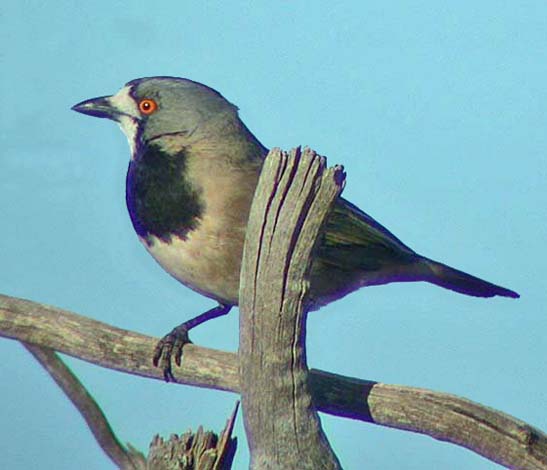
a web page by Don Roberson |
CRESTED BELLBIRD & ALLIES Oreoicidae |
|
As there is no family in which to place these three birds, they are tentatively assigned to a new family, the Oreoicidae. Although I use the English name "Crested Bellbird and allies" for this tentative family, it is not a good name for the group. We can't use "bellbirds' because there is already a group of impressive bellbirds among the New World cotingas (genus Procnias in family Cotingidae), and the name "bellbirds" is well established for them. There is also a totally different "bellbird" in New Zealand (Anthornis melanura), which is a honeyeater. Perhaps these three odd Australasian species in the newly discovered clade might be called "oreoicids." ["Oreo" is well known cream-filled chocolate cookie in the U.S., so it is an easy name for me to remember.] |
The Crested Bellbird of Australia is by far the best known species among this new group. It is traditionally been considered a whistler (Pachycephalidae). Its call, a series of two slow notes and three quick notes, is a characteristic sound in arid mulga and mallee within its range. Its aboriginal name "panpanalala" is alliterative for that call. The vocalization has a ventriloquil quality, and the bird itself can be hard to spot. I recall being led on a grand chase after it through the mallee of Wyperfeld National Park — and getting myself lost in the process! Apparently Crested Bellbird feeds primarily on the ground, and this behavior recalls wedgebills, with whom they have been associated in the past. The bird is said to have the "curious habit or ornamenting its nest with hairy caterpillars. It squeezes the caterpillars. around the middle, making them semi-immobile, and then attaches them to the rim of the nest. .... The young apparently do not eat the ornamental caterpillars." (Frith 1979). |
Research by Dumbacher et al. (2008) and Jønsson et al. (2008) found that the New Guinea birds called pitohuis were not closely related at all. Indeed, the evidence is that they belong to four separate families! The "true" Pitohuis — Variable Pitohui Pitohui kirhocephalus and Hooded Pitohui P. dichrous — are the only ones that belong in the genus Pitohui. They are the now-famed "poisonous birds," and they are closely related to Old World orioles (Oriolidae). One of the remained "pitohuis" is Crested Pitohui. It is now considered part of this new clade. It is possible that both the "whistler" and the "pitohui" will retain their English names, just as "robins" or "flycatchers" are names that are scattered throughout many families. The names just will no longer have taxonomic meaning. |
Norman et al. (2009) suggest some parallels in the distribution of Australasian birds to the odd distribution of the three oreoicids. They point out that the family Cinclosomatidae there are several species of quail-thrushes in the dry interior of Australia, and several species of jewel-babblers that replace each other elevationally in the foothills and mountains of New Guinea. Thus, like that family, the Oreoicidae contains birds of the dry country of Australia with close relatives in the damp and steamy jungles of montane New Guinea. This is all brand-new stuff, and time will tell if this group lasts long as a family. It may prove to have additional members, or further research may place it within some traditional family. We'll just have to wait and see. In the meantime . . . go see one. |
Photos: Paul Hackett photographed the Crested Bellbird Oreoica gutturalis near Waikerie, South Australia in 2002, presumably in the austral spring. Nik Borrow photographed the Rufous-naped Whistler Aleadryas rufinucha at Kumul Lodge, Papua New Guinea, on 22 Sep 2005. Photos © Paul Hackett (Bellbird) and © Nik Borrow (Whistler) and used with permission; all rights reserved. Bibliographic note: There is no "family book" covering the Oreoicidae, but good photographs and information about Australian and New Guinea species are found in Frith (1979) and Coates (1990), respectively. Literature cited:
|
 Recent
molecular evidence has discovered several lineages of birds, apparently
not closely related to other groups, that were entirely unexpected. One
of them is this set of three species in Australasia: Crested Bellbird
(left, in a fine digiscope © Paul Hackett) of the arid interior
scrublands of Australia, Rufous-naped Whistler in the mountains of New
Guinea, and Crested Pitohui "Pitohui" [now proposed as Ornorectes] cristatus
of the foothills and lowlands of New Guinea. Although one would not
have guessed a close relationship, analysis of their DNA has found that
they consistently group together as closely related species, and quite
unrelated to anything else yet analyzed (Norman et al. 2009, Dumbacher
et al. 2008, Barker et al. 2004).
Recent
molecular evidence has discovered several lineages of birds, apparently
not closely related to other groups, that were entirely unexpected. One
of them is this set of three species in Australasia: Crested Bellbird
(left, in a fine digiscope © Paul Hackett) of the arid interior
scrublands of Australia, Rufous-naped Whistler in the mountains of New
Guinea, and Crested Pitohui "Pitohui" [now proposed as Ornorectes] cristatus
of the foothills and lowlands of New Guinea. Although one would not
have guessed a close relationship, analysis of their DNA has found that
they consistently group together as closely related species, and quite
unrelated to anything else yet analyzed (Norman et al. 2009, Dumbacher
et al. 2008, Barker et al. 2004).  Another member of this new family is Rufous-naped Whistler (right; in a fine shot © Nik Borrow) of the New Guinea mountains. It has been traditionally considered a whistler (
Another member of this new family is Rufous-naped Whistler (right; in a fine shot © Nik Borrow) of the New Guinea mountains. It has been traditionally considered a whistler (